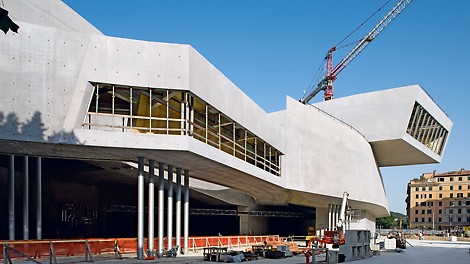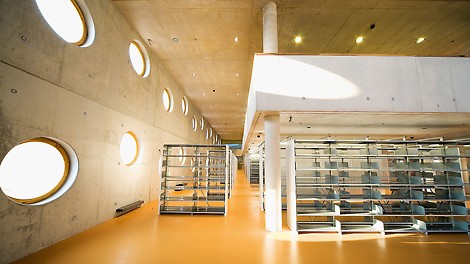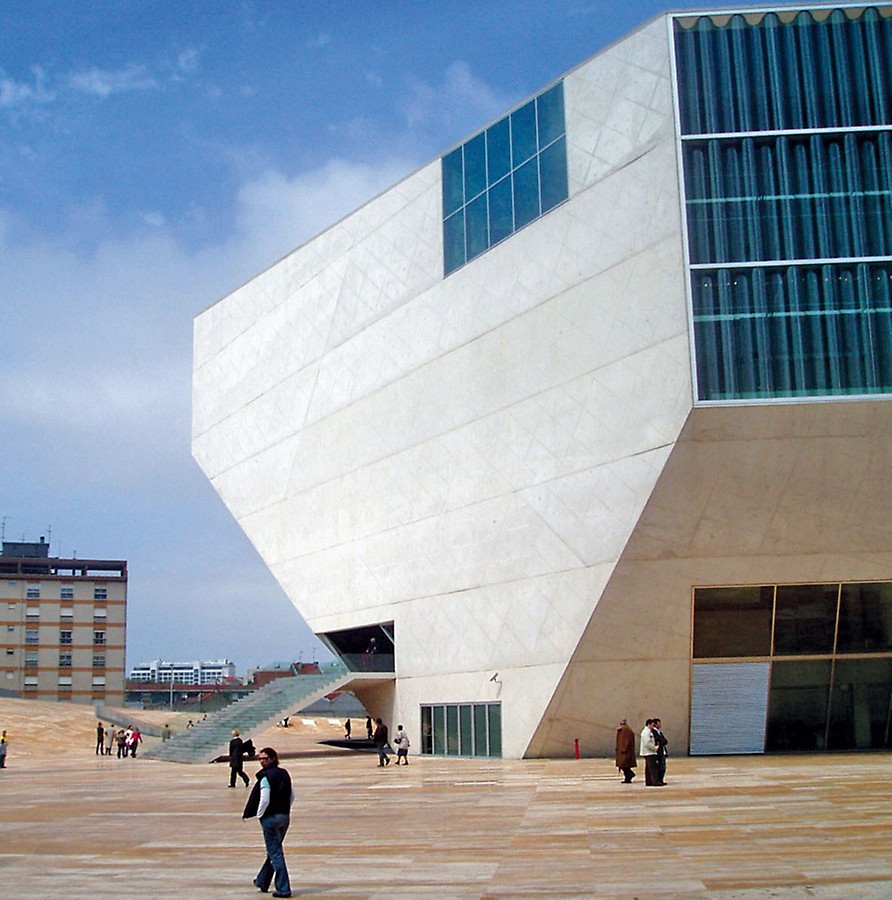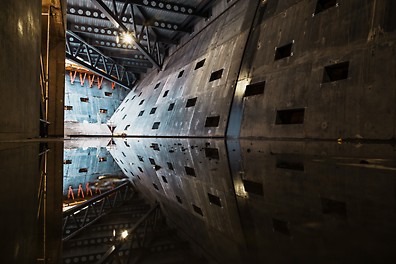
Kas töötate sellise projekti kallal?
Helista numbrile +372 677 11 00 või kirjuta e-mailile peri@peri.ee

Olgu see siis hingematvates kõrgustes või läbi äärmuslike vormide ja struktuuride – arhitektide nägemused muuseumide, kontserdisaalide, staadioni või sildade teostamiseks seavad ehitustööstusele üle maailma kõrgeimad võimalikud nõudmised.
Paljudel juhtudel on arhitektuurne betoon kaasaegne lahendus, olgu see siis tsiviilehituslikel, majanduslikel või esteetilistel põhjustel.
PERI pakub oma ehitusvaldkonna klientidele praktilist abi ja tuge: projekti nõuetele optimaalselt sobitatud voodri- ja raketisesüsteemide valimist, planeerimist ja tarnimist. Õige raketise lahendus igale arhitektuursele betoonpinnale, alates standardraketistest kuni eriprojektideni. Parimad tulemused sünnivad väga tihedas koostöös arhitektide, töövõtjate ja PERI inseneride vahel.
Arhitektuurne betoon on kaasaegses arhitektuuris mitmekülgne ja oluline disainielement. Seda saab kasutada peaaegu kõigi ehitustööde jaoks, võimaldades sobivate raketissüsteemide ja vormimise kaudu erinevaid kujundeid ja omadusi. Arhitektuurse betooni teket mõjutavad mitmesugused tegurid, nagu betoonisegu, pigmendid, eraldusained ja järgnevad pinnatöötlused.
Uute betoonitüüpide ja kiudbetoonide väljatöötamine avab täiendavaid rakendusi. Kuigi arhitektuurse betooni tootmiseks ei ole siduvaid eeskirju, on DBV "Arhitektuurse betooni" brošüüris toodud konkreetsed klassid ja kriteeriumid hea tehnilise toe jaoks. Soovitatav on pakkumiste, lepingute ja teenuste aluseks võtta see brošüür.
Selleks, et saavutada ainulaadsete betoonpindadega konstruktsioonid ja komponendid, on koostöö otsustava tähtsusega. Planeerijate ja klientide ootused ja nõudmised peavad olema vastavuses sellega, mis olla saab tegelikkuses saavutatud. Arhitektuurse betooni meeskonna loomine on ideaalne lahendus eduka tulemuse saavutamiseks.
Tavaliselt ei sõlmita lepingut planeerimisetapis, mistõttu on vaja konsulteerida pädevate spetsialiseerunud ettevõtete või kogenud inseneribüroodega. Valitud inseneribüroo saab seejärel tegutseda meeskonnas arhitektuurse betooni koordinaatorina.
Kaasaegses raketise ehituses kasutatakse peamiselt süsteemset raketist või raketist, mis koosnevad ühilduvatest süsteemikomponentidest. Sellel on eelised, nagu suuremad võimalused õigeks kasutamiseks, mitmekordistunud võimalikud kasutusvõimalused, väiksemad amortisatsioonikulud ja parem ohutus. Arhitektuursete betoonpindade puhul tuleb arvestada raketise kvaliteeti.
Paneelraketist kasutatakse peamiselt rendiraketisena erineva kasutusmäära ja remonditavate pindaladega, saavutades vaid SB 1 (D) ja SB 2 (C) arhitektuurse betooni klassid. Kõrgemad klassid nagu SB3 (A) ja SB4 (AA) ei ole rendipaneeli raketisega võimalikud ega piiratud, välja arvatud PERI MAXIMO.
Voodrivalik määrab betoonpinna struktuuri ja seda tuleks planeerimisel arvestada. Hankedokumentide kirjutamiseks on vajalikud teadmised materjalide omadustest, katetest ning koostoimetest eraldusainete ja värske betooniga.
Täpselt määratletud spetsifikatsioonid on vajalikud selleks, et töövõtja saaks valida sobiva vormi ja hinnata teostatavust, tolerantse ja tulemuste kõikumisi. Neli betooni pinda mõjutavad tegurid on imavus, valgus/tumedus, tekstuur ja vuugid/kinnitus.









Arhitektuurne betoon on kaasaegses arhitektuuris mitmekülgne ja oluline disainielement. Seda saab kasutada peaaegu kõigi ehitustööde jaoks, võimaldades sobivate raketissüsteemide ja vormimise kaudu erinevaid kujundeid ja omadusi. Arhitektuurse betooni teket mõjutavad mitmesugused tegurid, nagu betoonisegu, pigmendid, eraldusained ja järgnevad pinnatöötlused.
Uute betoonitüüpide ja kiudbetoonide väljatöötamine avab täiendavaid rakendusi. Kuigi arhitektuurse betooni tootmiseks ei ole siduvaid eeskirju, on DBV "Arhitektuurse betooni" brošüüris toodud konkreetsed klassid ja kriteeriumid hea tehnilise toe jaoks. Soovitatav on pakkumiste, lepingute ja teenuste aluseks võtta see brošüür.

Selleks, et saavutada ainulaadsete betoonpindadega konstruktsioonid ja komponendid, on koostöö otsustava tähtsusega. Planeerijate ja klientide ootused ja nõudmised peavad olema vastavuses sellega, mis olla saab tegelikkuses saavutatud. Arhitektuurse betooni meeskonna loomine on ideaalne lahendus eduka tulemuse saavutamiseks.
Tavaliselt ei sõlmita lepingut planeerimisetapis, mistõttu on vaja konsulteerida pädevate spetsialiseerunud ettevõtete või kogenud inseneribüroodega. Valitud inseneribüroo saab seejärel tegutseda meeskonnas arhitektuurse betooni koordinaatorina.

Kaasaegses raketise ehituses kasutatakse peamiselt süsteemset raketist või raketist, mis koosnevad ühilduvatest süsteemikomponentidest. Sellel on eelised, nagu suuremad võimalused õigeks kasutamiseks, mitmekordistunud võimalikud kasutusvõimalused, väiksemad amortisatsioonikulud ja parem ohutus. Arhitektuursete betoonpindade puhul tuleb arvestada raketise kvaliteeti.
Paneelraketist kasutatakse peamiselt rendiraketisena erineva kasutusmäära ja remonditavate pindaladega, saavutades vaid SB 1 (D) ja SB 2 (C) arhitektuurse betooni klassid. Kõrgemad klassid nagu SB3 (A) ja SB4 (AA) ei ole rendipaneeli raketisega võimalikud ega piiratud, välja arvatud PERI MAXIMO.

Voodrivalik määrab betoonpinna struktuuri ja seda tuleks planeerimisel arvestada. Hankedokumentide kirjutamiseks on vajalikud teadmised materjalide omadustest, katetest ning koostoimetest eraldusainete ja värske betooniga.
Täpselt määratletud spetsifikatsioonid on vajalikud selleks, et töövõtja saaks valida sobiva vormi ja hinnata teostatavust, tolerantse ja tulemuste kõikumisi. Neli betooni pinda mõjutavad tegurid on imavus, valgus/tumedus, tekstuur ja vuugid/kinnitus.
Tänapäevased konstruktsioonid ja ehitusmeetodid võimaldavad teostada muljetavaldavaid arhitektuurilisi kontseptsioone. Allpool näete mõningaid projekte, mille kallal oleme nende kontseptsioonide saavutamiseks töötanud.

Helista numbrile +372 677 11 00 või kirjuta e-mailile peri@peri.ee